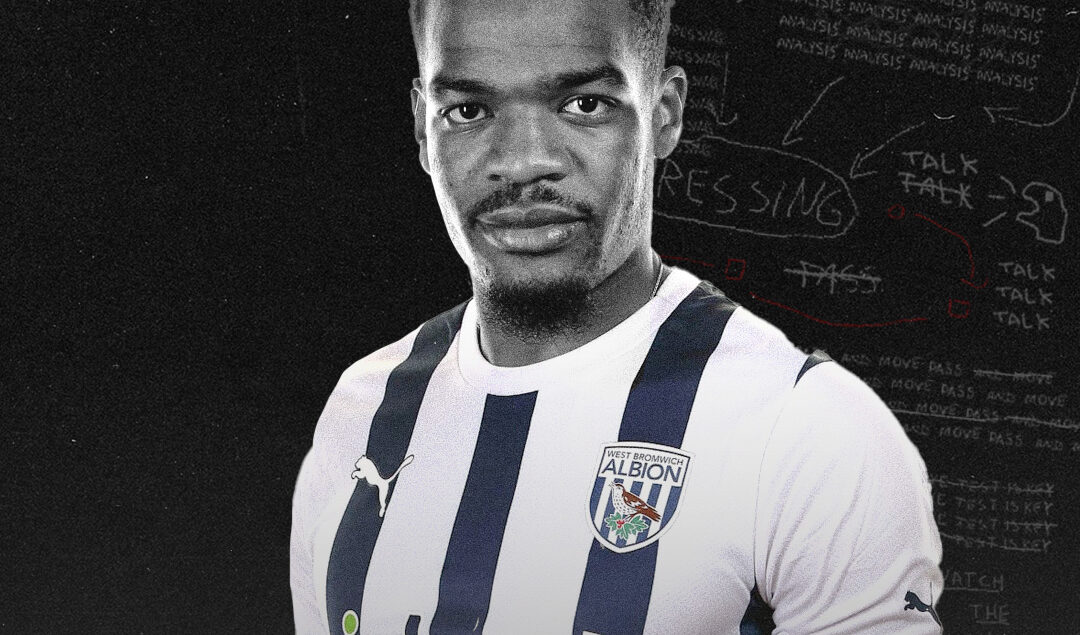Carlos Corberan’s Tactical Set-up at West Brom
Carlos Corberan joined West Brom with the club in the relegation zone midway through last season. His arrival sparked an impressive turnaround which saw them just miss out on a play-off place in the final game of the season. With the club in financial turmoil and the loss of Dara O’Shea, most West Brom fans were anticipating a bottom-half finish this season. Corberan however, saw the potential in the squad and has them in fifth place following a narrow 1-0 win to Norwich City. He’s created an adaptable team capable of beating the teams below them with relative ease whilst mixing it with those at the top end of the division.
Comfortable in All Defensive Phases
West Brom conceded 11 goals in their first six competitive games this season but have since been the best defensive side in the division, topping the league in clean sheets. This is enabled by their players knowing their responsibilities in each defensive phase.
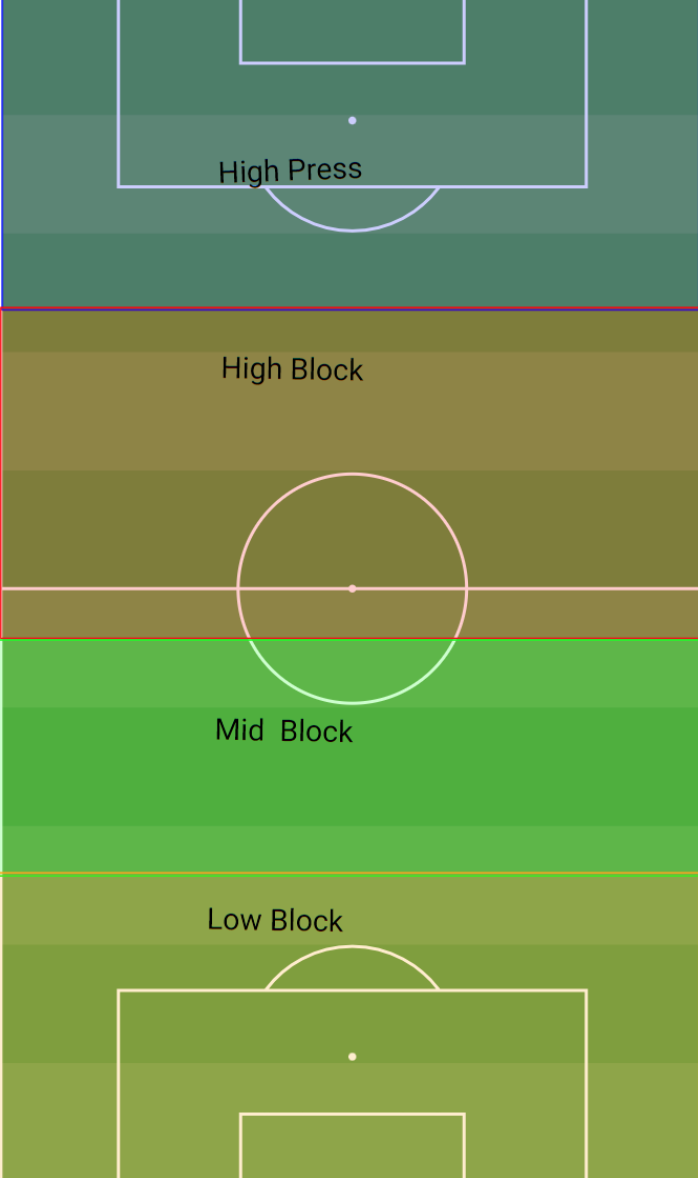
West Brom’s defensive zone map
In defence West Brom have four defensive zones. These zones are dependent on where the opponent has the ball and guide the player’s decision-making out of possession.
High Press
West Brom’s press changes dependent on the opposition but it’s always based on the principle that if they can press the opponent into zones they want them and run with intensity they can win the ball back. In their 2-1 defeat against Leicester, they looked to push The Foxes inside and force mistakes high up the pitch. They did this by marking man-for-man on goal kicks and pressing on the outside of the opposition.
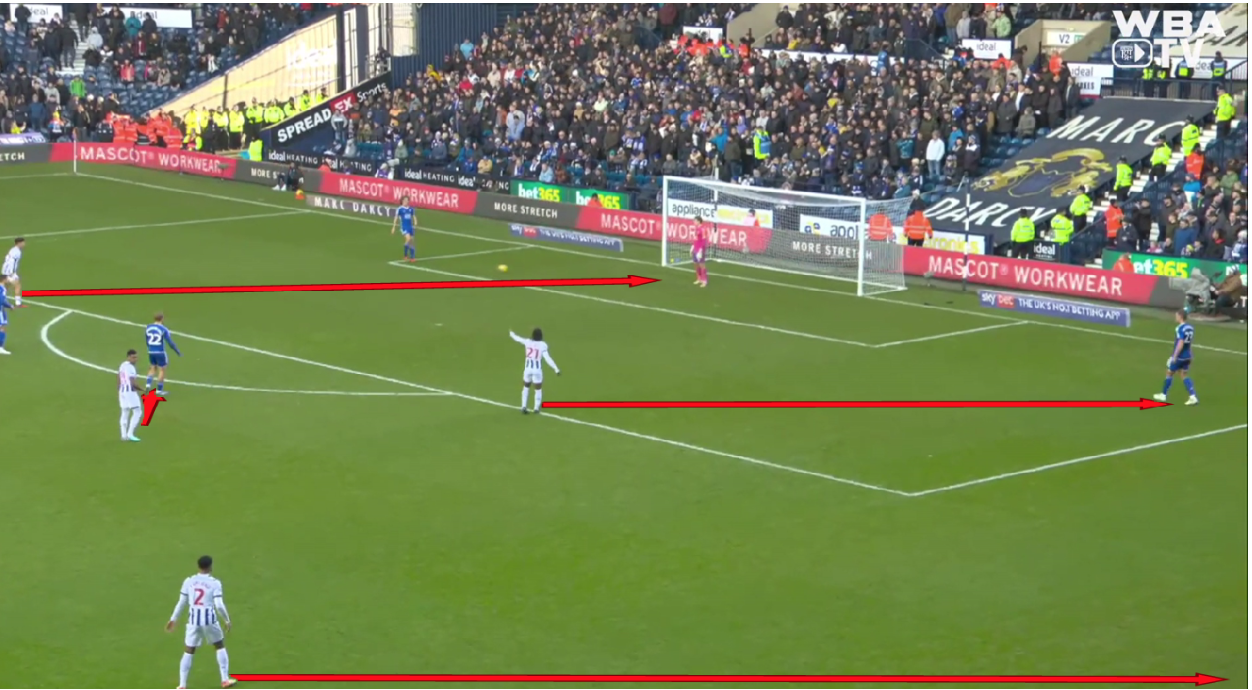
West Brom’s set-up in a man-for-man press on a Leicester goal kick
The image above shows West Brom’s set-up on Leicester’s goal kicks. Every player is aware of their marker and ready to close them down if they receive the ball.

Wout Faes (Leicester’s right centre-back) restarted play with a pass to his goalkeeper, this is a trigger for Jeremy Sarmiento to begin his press. He approaches slowly waiting for Mads Hermansen (Leicester’s goalkeeper) to move the ball before engaging at full speed. Brandon Thomas-Asante also creeps closer to the other Leicester centre-back, Jannik Vestegaard in case Hermansen passes left.
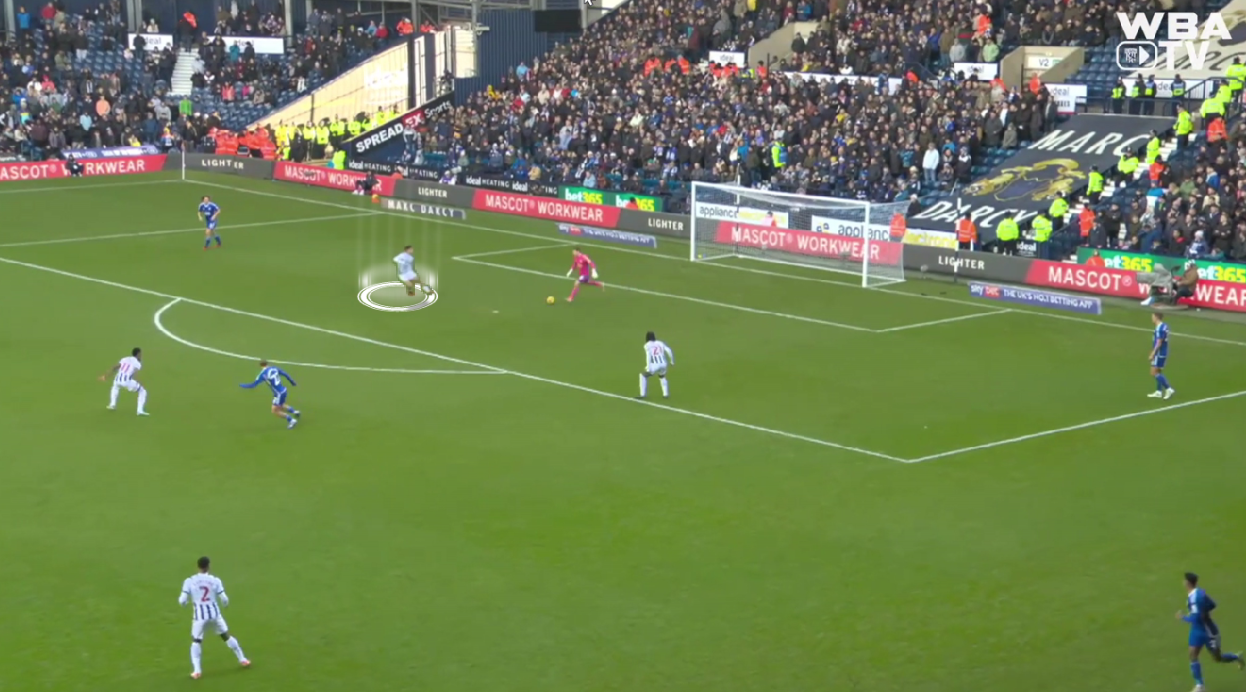
Once Hermansen has begun moving the ball Sarmiento sprints at an angle blocking the pass to Faes, forcing the goalkeeper to either loft a pass to his fullback or play into midfield. As well as this, Hermansen moving forward indicates that he isn’t going to pass to Vestegaard which leads to Thomas-Asante maintaining his position on the edge of the box, blocking the ground pass to Leicester left-back James Justin whilst keeping him in position to receive the ball if West Brom win it back.

This forces a mistake from the Hermansen who mishits his pass into midfield, allowing Furlong to intercept. The press in the game against Ipswich aimed to take advantage of their 4-1 build-up shape by having the front two stay narrow and close to Ipswich midfielder Sam Morsy, making a pass into his feet dangerous, whilst still being close enough to press their centre-backs should they receive the ball. It was a change in approach but the principles remained the same.
High and Mid-block
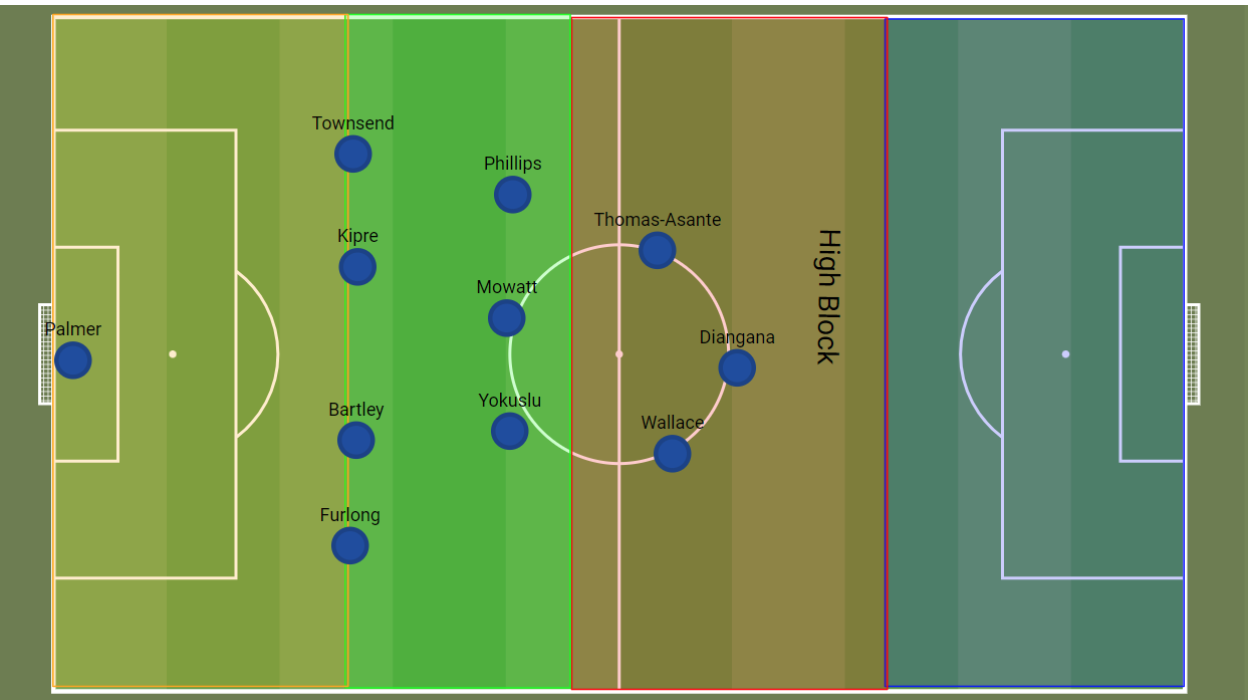
West Brom’s shape in the high block can change minimally dependant on openent. It’s either a 4-3-3 or a 4-4-2 with the difference being how high the right winger starts. In the high block, they look to block passes into midfield and attempt to trap them wide where the full-back, winger and ball-side midfielder are quick to press.
If the opponent does play centrally they’re compact enough to get bodies around the ball and win it back. Despite this, they do struggle with fizzed passes from a wide centre-back into technical players between the lines due to the midfield’s lack of agility.

When in a 4-3-3 they often try to tilt the midfield to the left side of the pitch to reduce distances between players. To achieve this without getting overloaded on the other side of the pitch the forwards have to press on the outside of the wide and central centre-back body to force passes across the defence and into the overloaded left side. The high block relies on intense running from the forwards, aggression from the midfielders and an excellent sense of positioning throughout the team.
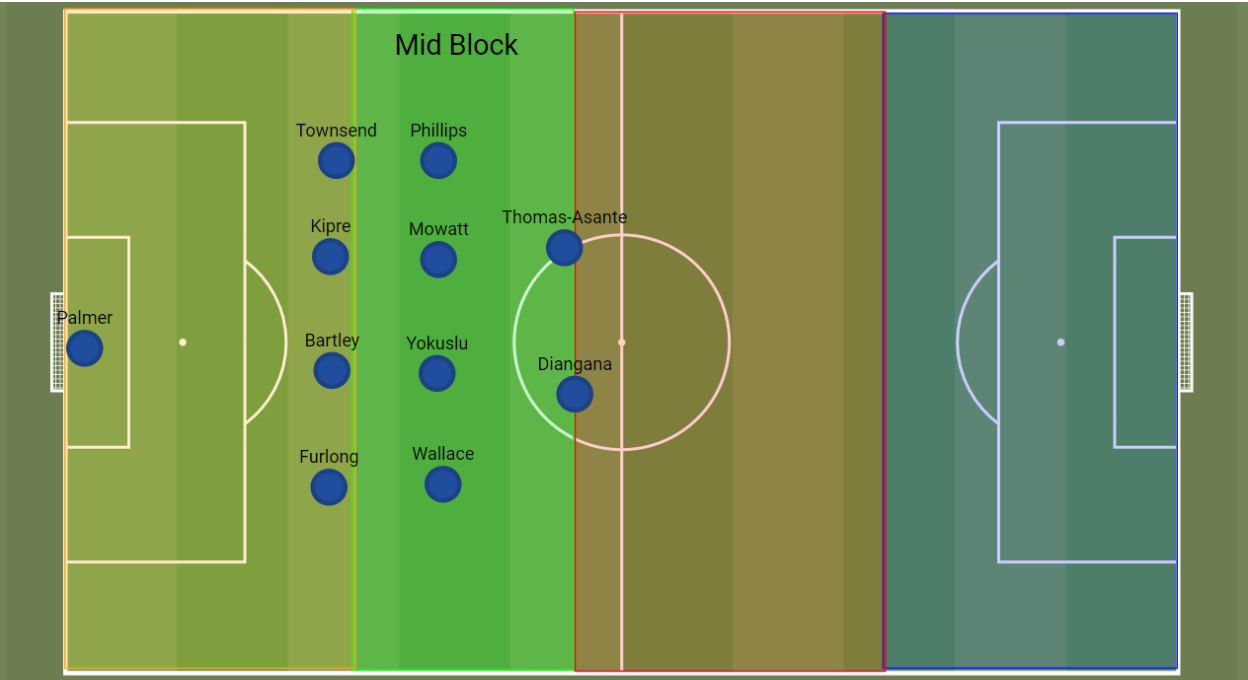
In the mid-block, they settle in a 4-4-2 shape and become more compact. They aim to block central progression whilst pushing the opponent back if possible. The principles are very similar to those in the high block, but there’s less intensity.
Low Block
Carlos Corberan has coached the most compact and disciplined low block in the Championship at West Brom. They give up little space in central areas and have the desire to put their body on the line in the penalty area.

West Brom’s 4-4-2 low-block
In the low block, West Brom bring both forwards back to create a narrow 4-4-2 which is less than the width of the penalty area when the ball is central.

When the ball is wide both fullback and winger shuffle across to create a 2v1 in the defender’s favour, momentarily shifting the formation to a 5-3-2. A problem with the fullback coming across is that they are not followed by the centre-backs who prefer to stay central and compete for headers. This leaves a large space between fullback and centre back which could be exploited by the opposition.
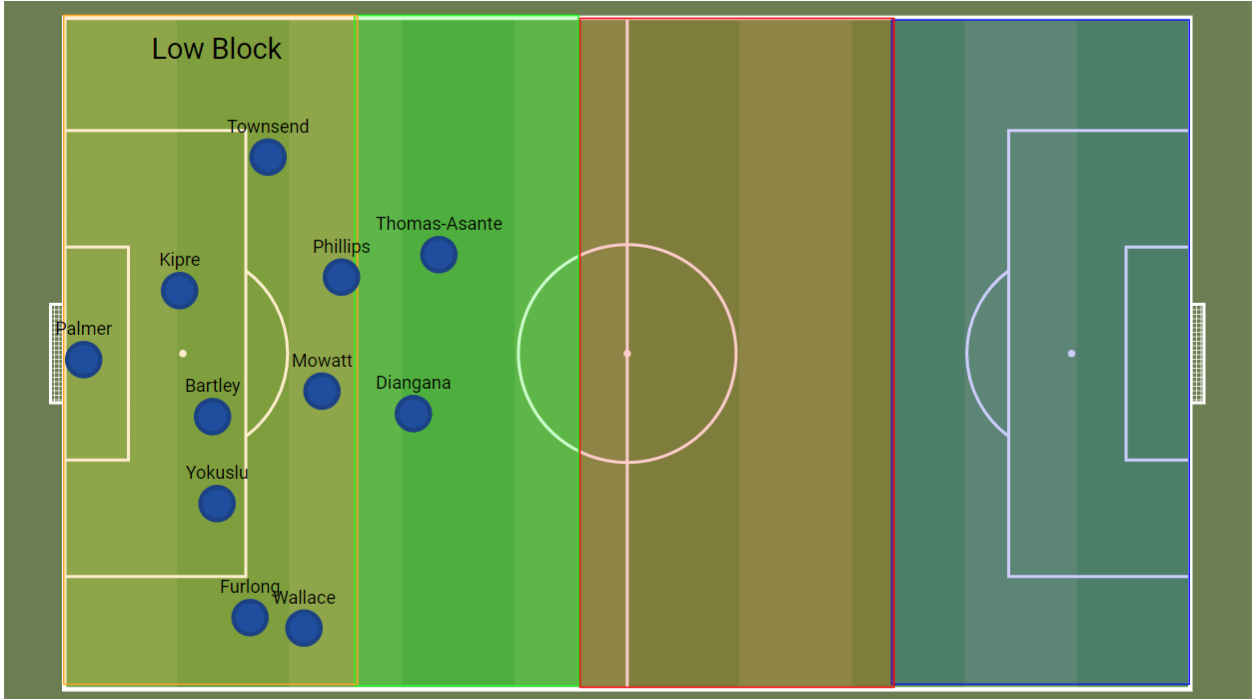
Corberan wants this gap to be filled by one of the midfielders but Alex Mowatt struggles to keep track of runners in this space.
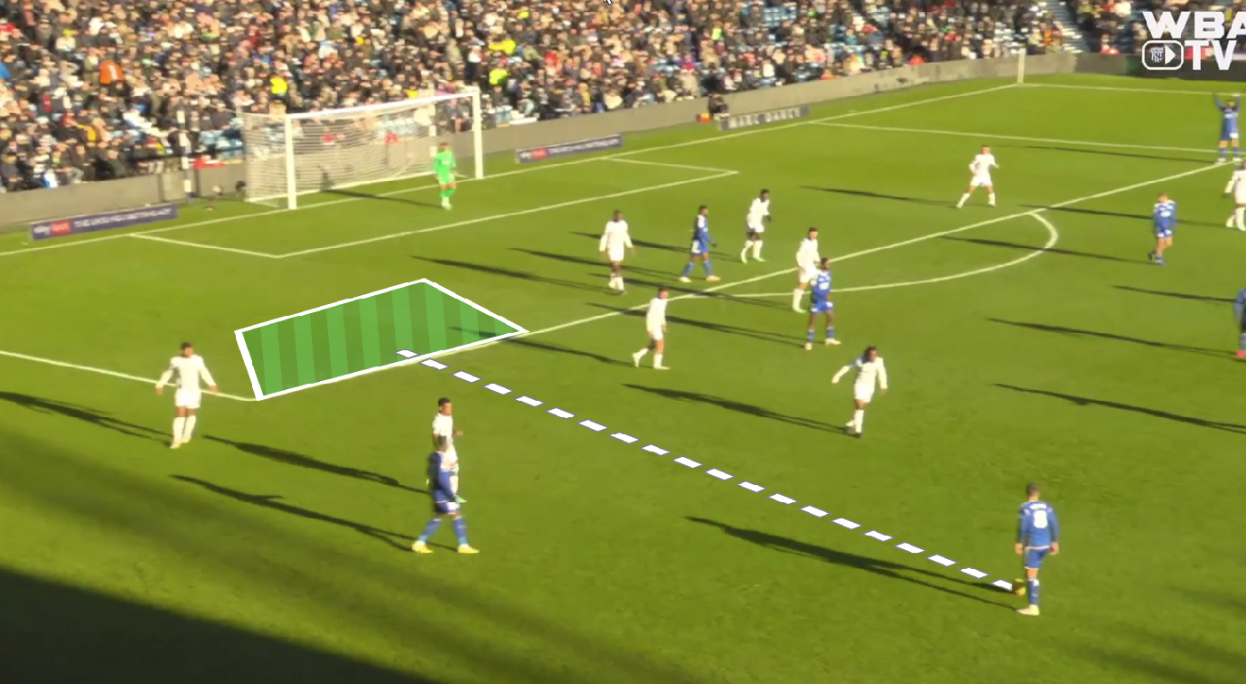
Passes into this zone have caused West Brom problems on several occasions this season, conceding goals to Birmingham City and Southampton, and will only evolve into a bigger issue as teams seem to have started exploiting it more often now.
Artificial Transitions
A common theme under Corberan has been West Brom’s ability to create artificial transitions in settled play by baiting the press and playing into space. A perfect example of this is Matt Phillips’ goal against Hull City.
𝗔𝗹𝗯𝗶𝗼𝗻-𝗯𝗮𝗹𝗹 😍 pic.twitter.com/MSuEh1vafW
— West Bromwich Albion (@WBA) November 5, 2023
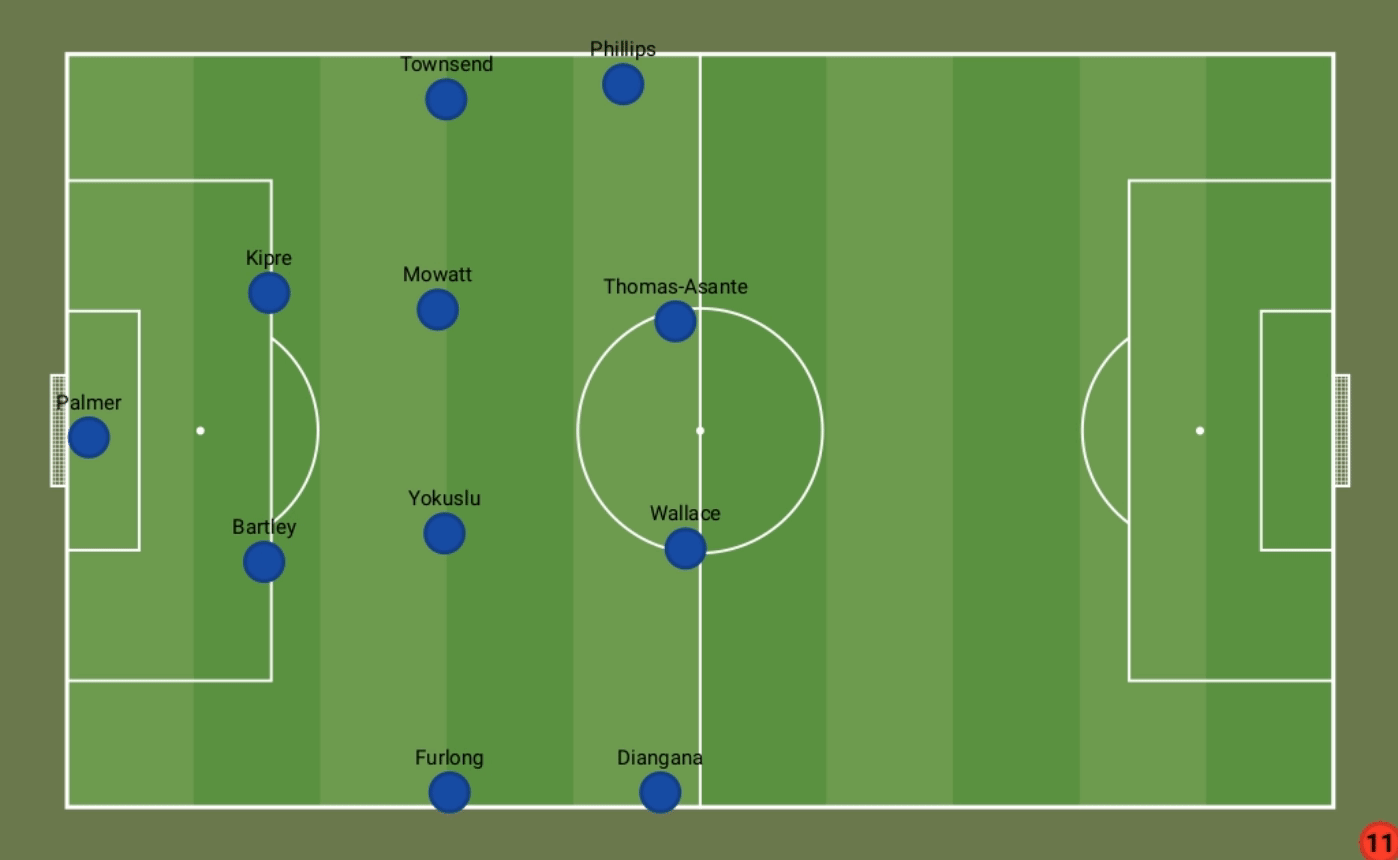
When building out this way they start in a 2-4-4 with the full-backs wide and ready to be used as an out ball. But as play progresses up the pitch it isn’t uncommon for Furlong to shift across to a right-centre-back position creating a 3-2-5 as Townsend pushes further forward, ready to make overlapping runs if Phillips receives the ball to feet.
To create the opportunity they use forward-backward-forward combinations in midfield to escape pressure and get the ball into the forward line. Once the attackers have the ball the principles are simple. Play the ball wide and into space whilst committing defenders, keep the other attackers between the posts and trust the winger to pick the right pass or get a shot away.
Build-up
When the opposition doesn’t allow for artificial transitions the wingers move inside to help create overloads and help move the ball into wide positions. This form of build-up aims to open up passes into the striker’s feet or to runners in behind. Against Leicester, they used positional rotations to drop between centre-backs and move the ball forward efficiently.

The play begins with Palmer on the ball centrally. West Brom are in their 2-4 shape with Kipre and Ajayi either side of the box, Mowatt and Okay Yokuslu the width of the defense and Conor Townsend and Darnell Furlong wide (out of frame).

Palmer passes the ball to Kipre, causing Mowatt to drop between the defenders.

Mowatt passes the ball back to Palmer, who plays the ball to Ajayi which makes Yokuslu drop.
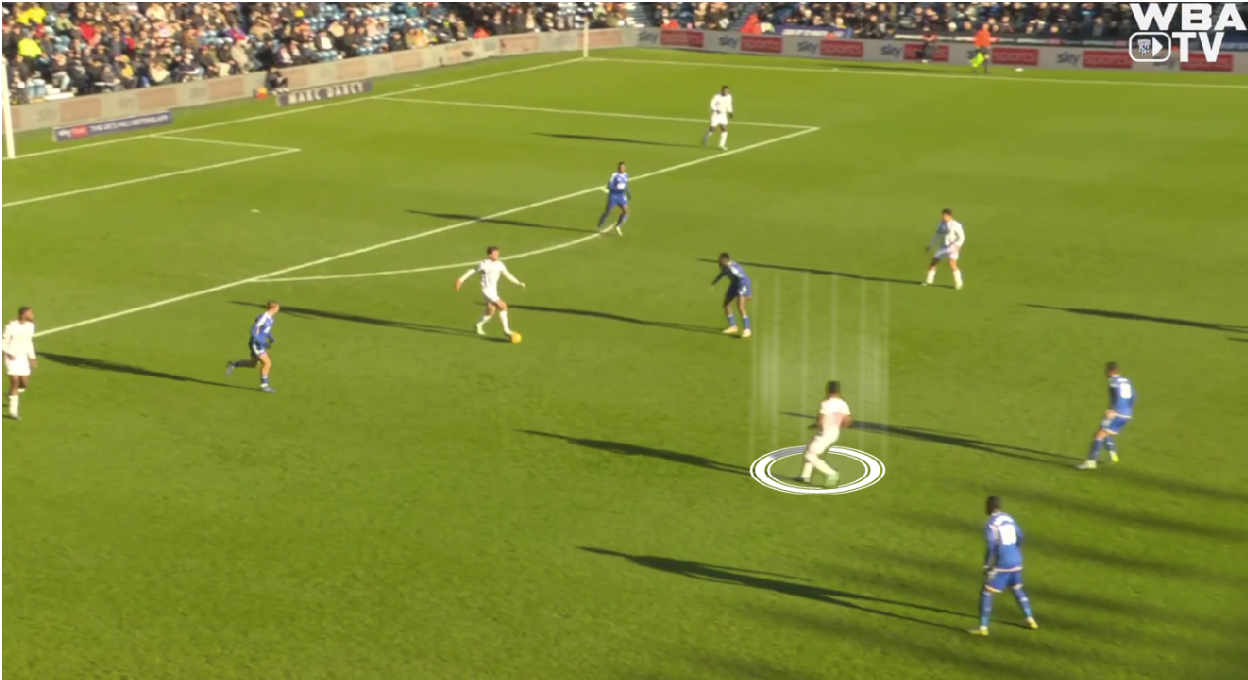
These four passes have created enough space for Yokuslu to turn and carry into midfield. Diangana has dropped deep, looking to recycle play.
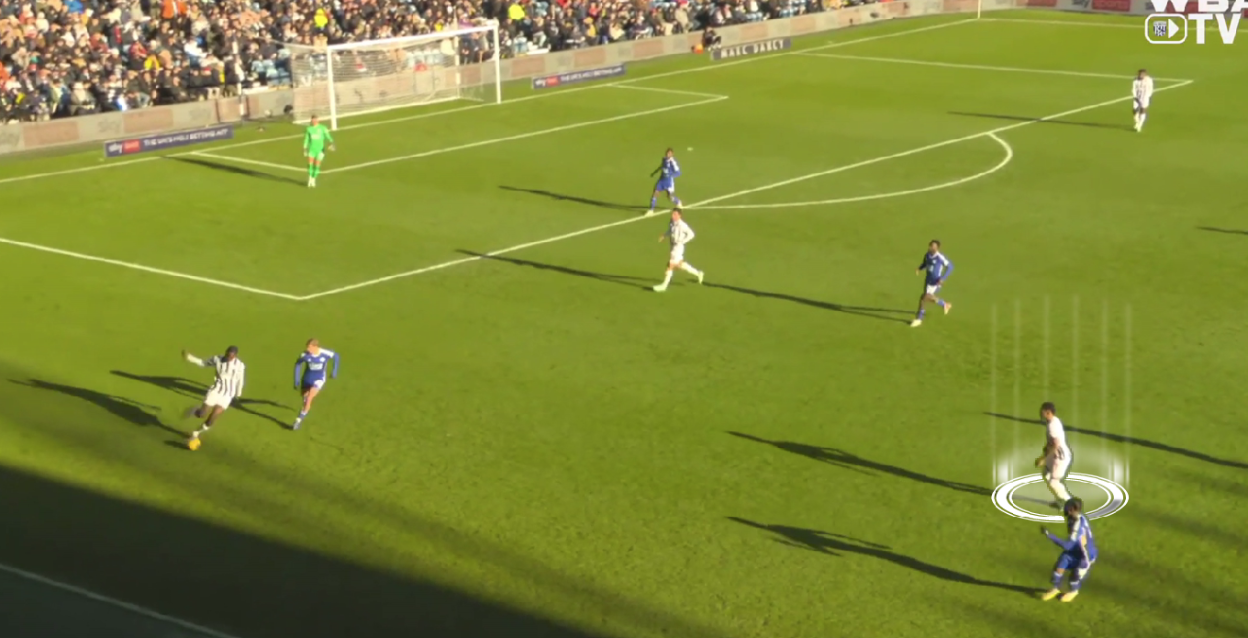
Diangana plays a first-time pass into Ajayi and stays central, allowing Furlong to push into a more advanced position.
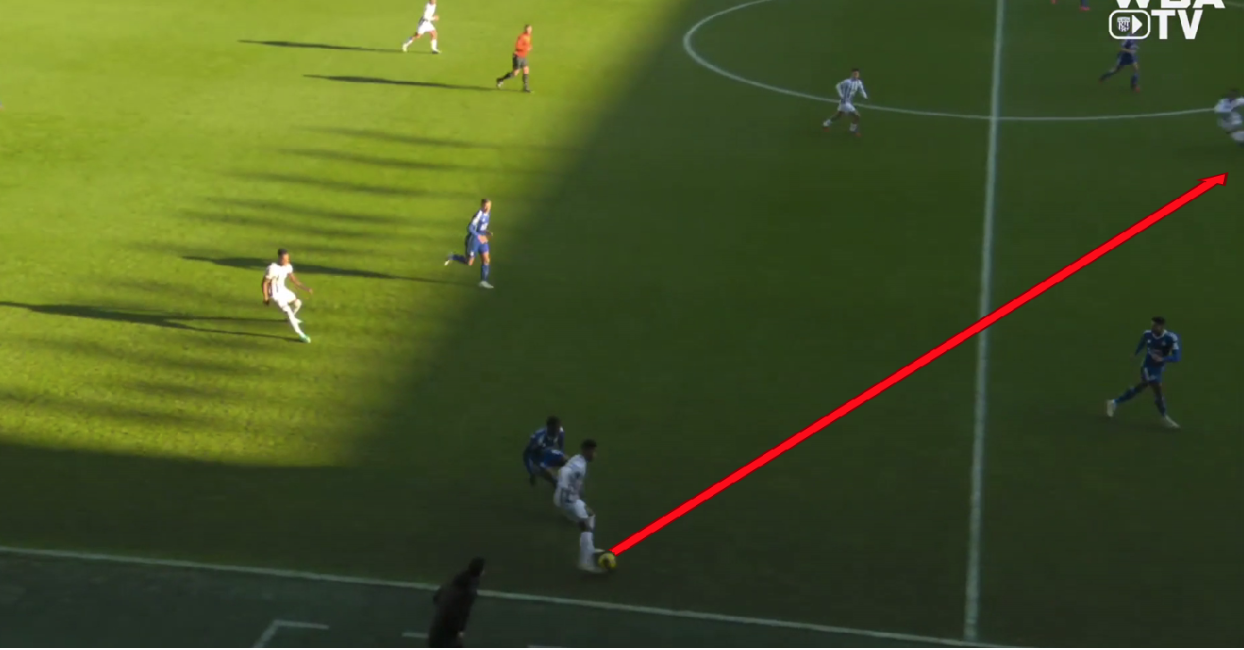
Once Furlong receives the ball, he’s immediately looking to play the ball into Thomas-Asante’s feet.

Ultimately this move led to nothing due to Thomas-Asante taking his first touch backwards and a lack of a runner on the right, a problem that will be solved upon Jed Wallace’s return from injury, but it’s an example of how West Brom can manipulate an opponent by moving the ball slowly from out to in before being direct when the opportunity presents itself.
Using Off-The-Ball Movement to Create an Open Wide Man
West Brom are good at using movement to create space for players to ghost into out wide. The best example of this is their attacking midfielder drifting into space left by full-backs following Diangana deep:
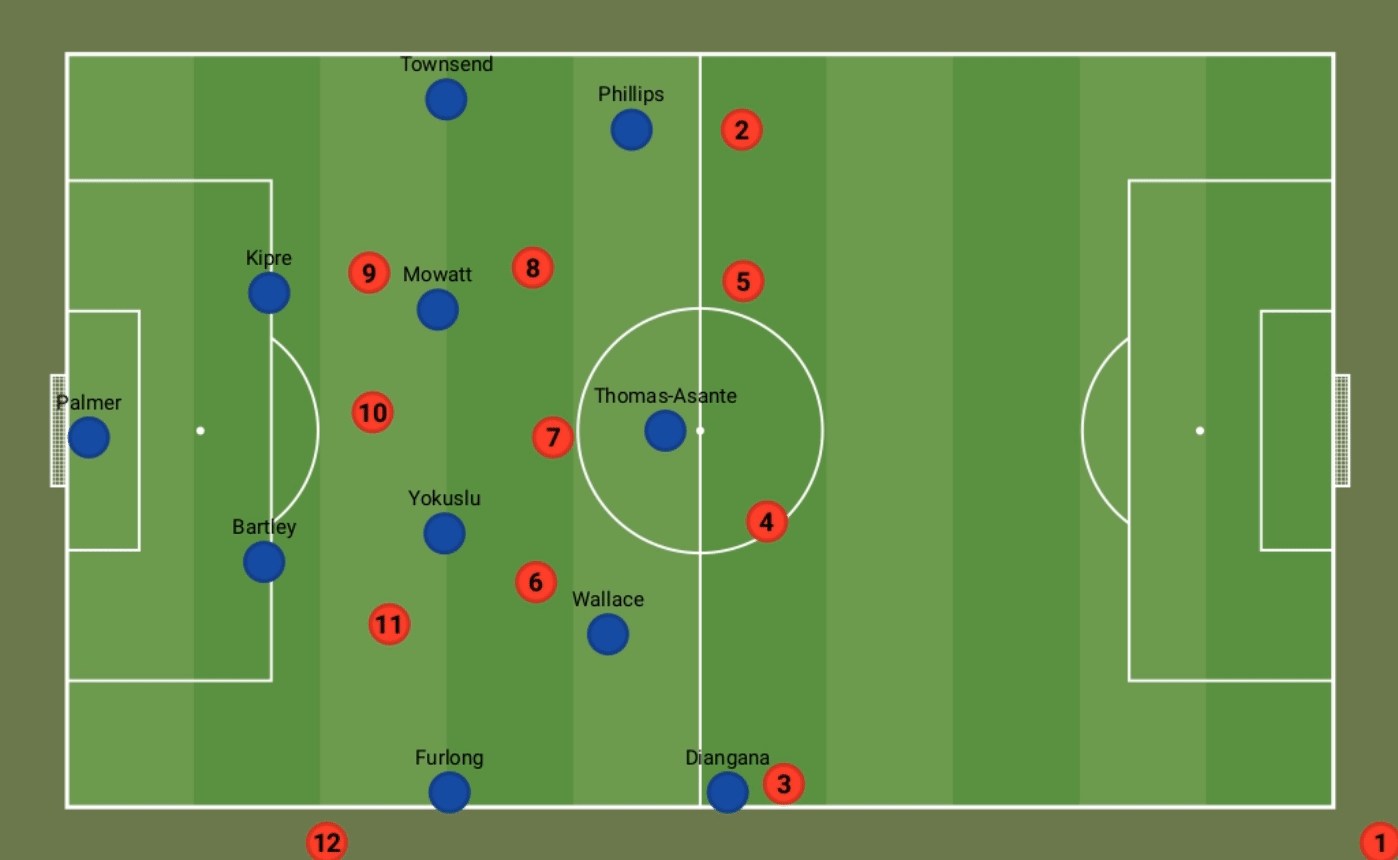
A similar pattern can be seen when Furlong moves into midfield before pushing wide when Diangana receives the ball:

These movements are worked on in training and they’re an excellent way of creating space for wide players. The trade-off is that you’d rather have Diangana arriving onto the ball with space to run into.
Problems against Set Defences
West Brom scores most of their goals from transitions and set pieces. Against set defences, they often play themselves out of promising positions. One of the biggest issues is a lack of a quality finisher in the box. Thomas-Asante for all his good work struggles to attack a moving ball.
This has led to West Brom trying to create cut-back opportunities with short passes and combinations in wide positions. The problem with this is that neither fullback offers much threat high and wide. This leads to play slowing down whilst they try and work a winger into open space out wide.
The wingers also struggle in isolated 2v1s but have shown themselves to be dangerous in one one-on-one situations, this explains why they’ve scored a few goals from short throw-ins and Sarmiento’s goal against Cardiff. In the last few games, they’ve switched from trying to work cutbacks to instructing the wingers to cut inside and play inswinging crosses to the back post. This has had mixed success but against Sunderland, Pipa’s cross was headed home by Thomas-Asante.
Conclusion
West Brom aren’t perfect but Corberan has taken a team that looked destined for relegation when he first joined to fifth whilst playing exciting, transition-based football. They’re the best defensive team in the league and should be in and around the playoffs come May. If they don’t have a new owner by January they’ll likely lose some players but Corberan has shown his ability to adapt to the loss of key players already this season. With him in charge, West Brom will be fine.
By: @rickyleegriffi2 / Ricky Lee Griffiths
Featured Image: @GabFoligno / Adam Fradgley / West Brom
